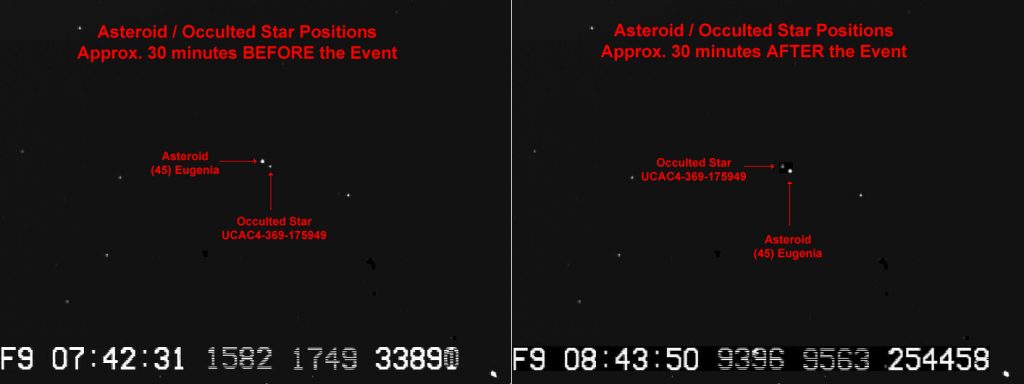An Interesting Main Belt Asteroid and Recent Occultation Observation
From Wikipedia: “Eugenia was discovered on 27 June 1857 by the Franco-German amateur astronomer Hermann Goldschmidt. His instrument of discovery was a 4-inch aperture telescope located in his sixth floor apartment in the Latin Quarter of Paris. It was the forty-fifth minor planet to be discovered. The preliminary orbital elements were computed by Wilhelm Forster in Berlin, based on three observations in July, 1857.
Eugenia is a large asteroid, with a diameter of 214 km. It is an F-type asteroid, which means that it is very dark in coloring (darker than soot) with a carbonaceous composition. Like Mathilde, its density appears to be unusually low, indicating that it may be a loosely packed rubble pile, not a monolithic object.”
In 1998 astronomers discovered that Eugenia had a moon. It was the first discovery of a moon orbiting an asteroid by a ground based telescope. The discoverers name the moon Petit-Prince. The moon, about 13 km in diameter, orbits Eugenia in about 5 days. Discovered in 2004 a smaller moon, at about 6 km, orbits Eugenia every 4.7 days and is designated S/2004 (45) 1.

Earlier this month, 45 Eugenia was predicted to occult an 11.8 magnitude star (UCAC4-369-175949) in the constellation Sagittarius. The maximum duration of the event was predicted to be 20.6 seconds with a magnitude drop of 0.4 – 0.5. The predicted path extended from central Montana, through Idaho, northern Nevada and northern California. An announcement of the event was distributed to observers across the west in an attempt to perhaps observe the known moon, Petit-Prince.

Predicted event time was approximately 08:12:45 +/- 2 sec UT (01:12:45 PDT). There have been a number of previous occultation events by Eugenia over the years, with 13 positive chords recorded in 2014 and 7 positive chords in 2017.
Because of its size, Eugenia is a fairly bright object at mag 11.2 and is easily discernible from the target star as seen on the two images below. These images were extracted from integrated video taken as the asteroid approached the target star and after the predicted event. Time stamp data for each of the images is shown at the bottom of each frame.

I was able to record the event with a 304 mm SCT equipped with a 3.3 focal reducer, WAT910 HX B/W video camera and IOTA-VTI time stamp inserter. Video was recorded with no integration at 2X. Light curve data and occultation event timing extraction was completed using a new set of programs authored by Bob Anderson in conjunction with the North American International Occultation Timing Association (IOTA).
The recently released PyMovie is available at: http://occultations.org/observing/software/pymovie/.
PyOTE is available on the IOTA web page at: http://www.asteroidoccultation.com/observations/NA/.

At my observing location in Gardnerville, Nevada I observed an occultation event with duration of 19.1 seconds (starting at 08:12:43.489 and ending at 08:13:02.574 UT). Calculated mag drop was 0.44.

Unfortunately, of the six other observers that had planned to also participate, all were clouded out of the event.
